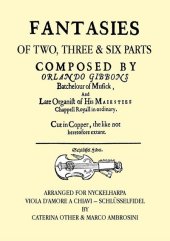 Neuerscheinungen 2017Stand: 2020-02-01 |
Schnellsuche
ISBN/Stichwort/Autor
|
Herderstraße 10
10625 Berlin
Tel.: 030 315 714 16
Fax 030 315 714 14
info@buchspektrum.de |

Marco Ambrosini, Orlando Gibbons, Caterina Other
(Beteiligte)
Fantasies, arranged for Nyckelharpa, Viola d´Amore a Chiavi - Schlüsselfidel
Bearbeitung: Other, Caterina; Ambrosini, Marco
2017. 46 S. 29.7 cm
Verlag/Jahr: VERLAG DER SPIELLEUTE 2017
ISBN: 3-943060-13-6 (3943060136)
Neue ISBN: 978-3-943060-13-3 (9783943060133)
Preis und Lieferzeit: Bitte klicken
In the last few years, the authors have noticed great interest in performances of Early Music by nyckelharpa players! Our beloved instrument, not only as a one more or less correct historical reconstruction, e.g. of the so-called "Siena keyed vielle" or the "Moraharpa", but also in its modern 4-row "continental" version, and its sound suit the music from the Late Middle Ages to Baroque perfectly.
Gibbons´s consort works have an exciting sound when performed by two or more nyckelharpor.
Some time ago, we started arranging this music for our students. Having spent a long time rehearsing and performing the Fantasies, we have finally decided to spread the word and share our work in the form of this publication.
This edition of the Fantasies is designed especially for 4-row nyckelharpor, tuned in fifths. Note that in nearly all cases, the upper voices are also suitable for 3-row instruments in both the traditional and fifth tunings.
An issue that arises in arranging music for different instruments of the nyckelharpa family is the musical clefs used in the scores. It is in this case a relatively recent debate, mostly unnoticed in the Scandinavian milieu, due to the wider dissemination on the continent of instruments with four rows of keys. The Swedish "traditional" instrument, with its tuning, the three rows of keys and the use of the fourth string as a drone, does not require writing notes below the third open string (G). For this reason the Swedish repertoire is normally written in the treble clef.
The case of four-rows-keyboard nyckelharpa is clearly different. How to write down the notes made possible by the keys on the fourth string? In this case we have decided to use three different ways of writing: treble clef (G clef), treble clef octave lower (G clef) and bass clef (F clef).
The book is written in English language.


